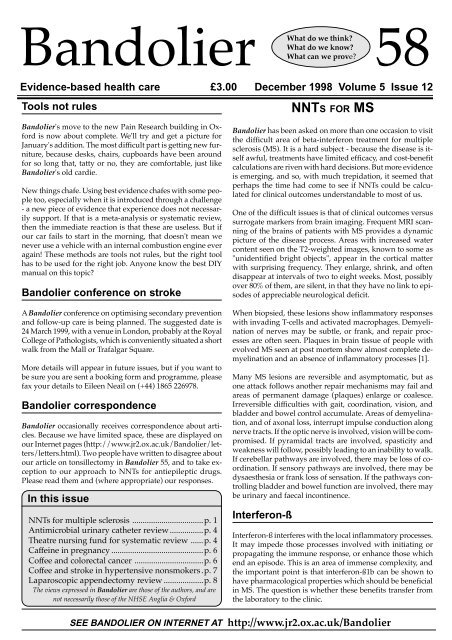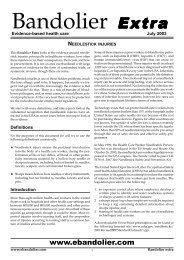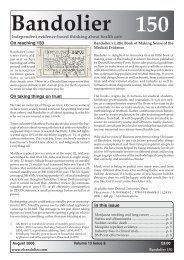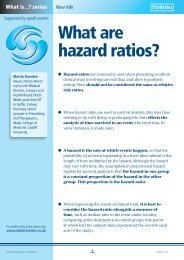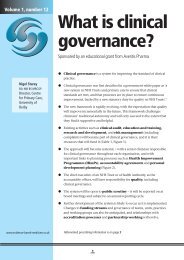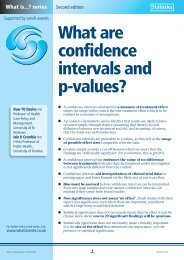You also want an ePaper? Increase the reach of your titles
YUMPU automatically turns print PDFs into web optimized ePapers that Google loves.
<strong>Bandolier</strong> <strong>58</strong><br />
What do we think?<br />
What do we know?<br />
What can we prove?<br />
Evidence-based health care £3.00 December 1998 Volume 5 Issue 12<br />
Tools not rules<br />
<strong>Bandolier</strong>'s move to the new Pain Research building in Oxford<br />
is now about complete. We'll try and get a picture for<br />
January's addition. The most difficult part is getting new furniture,<br />
because desks, chairs, cupboards have been around<br />
for so long that, tatty or no, they are comfortable, just like<br />
<strong>Bandolier</strong>'s old cardie.<br />
New things chafe. Using best evidence chafes with some people<br />
too, especially when it is introduced through a challenge<br />
- a new piece of evidence that experience does not necessarily<br />
support. If that is a meta-analysis or systematic review,<br />
then the immediate reaction is that these are useless. But if<br />
our car fails to start in the morning, that doesn't mean we<br />
never use a vehicle with an internal combustion engine ever<br />
again! These methods are tools not rules, but the right tool<br />
has to be used for the right job. Anyone know the best DIY<br />
manual on this topic?<br />
<strong>Bandolier</strong> conference on stroke<br />
A <strong>Bandolier</strong> conference on optimising secondary prevention<br />
and follow-up care is being planned. The suggested date is<br />
24 March 1999, with a venue in London, probably at the Royal<br />
College of Pathologists, which is conveniently situated a short<br />
walk from the Mall or Trafalgar Square.<br />
More details will appear in future issues, but if you want to<br />
be sure you are sent a booking form and programme, please<br />
fax your details to Eileen Neail on (+44) 1865 226978.<br />
<strong>Bandolier</strong> correspondence<br />
<strong>Bandolier</strong> occasionally receives correspondence about articles.<br />
Because we have limited space, these are displayed on<br />
our Internet pages (http://www.jr2.ox.ac.uk/<strong>Bandolier</strong>/letters/letters.html).<br />
Two people have written to disagree about<br />
our article on tonsillectomy in <strong>Bandolier</strong> 55, and to take exception<br />
to our approach to NNTs for antiepileptic drugs.<br />
Please read them and (where appropriate) our responses.<br />
In this issue<br />
NNTs for multiple sclerosis ..................................p. 1<br />
Antimicrobial urinary catheter review................p. 4<br />
Theatre nursing fund for systematic review ......p. 4<br />
Caffeine in pregnancy ............................................p. 6<br />
Coffee and colorectal cancer .................................p. 6<br />
Coffee and stroke in hypertensive nonsmokers.p. 7<br />
Laparoscopic appendectomy review ...................p. 8<br />
The views expressed in <strong>Bandolier</strong> are those of the authors, and are<br />
not necessarily those of the NHSE Anglia & Oxford<br />
NNTS FOR MS<br />
<strong>Bandolier</strong> has been asked on more than one occasion to visit<br />
the difficult area of beta-interferon treatment for multiple<br />
sclerosis (MS). It is a hard subject - because the disease is itself<br />
awful, treatments have limited efficacy, and cost-benefit<br />
calculations are riven with hard decisions. But more evidence<br />
is emerging, and so, with much trepidation, it seemed that<br />
perhaps the time had come to see if NNTs could be calculated<br />
for clinical outcomes understandable to most of us.<br />
One of the difficult issues is that of clinical outcomes versus<br />
surrogate markers from brain imaging. Frequent MRI scanning<br />
of the brains of patients with MS provides a dynamic<br />
picture of the disease process. Areas with increased water<br />
content seen on the T2-weighted images, known to some as<br />
"unidentified bright objects", appear in the cortical matter<br />
with surprising frequency. They enlarge, shrink, and often<br />
disappear at intervals of two to eight weeks. Most, possibly<br />
over 80% of them, are silent, in that they have no link to episodes<br />
of appreciable neurological deficit.<br />
When biopsied, these lesions show inflammatory responses<br />
with invading T-cells and activated macrophages. Demyelination<br />
of nerves may be subtle, or frank, and repair processes<br />
are often seen. Plaques in brain tissue of people with<br />
evolved MS seen at post mortem show almost complete demyelination<br />
and an absence of inflammatory processes [1].<br />
Many MS lesions are reversible and asymptomatic, but as<br />
one attack follows another repair mechanisms may fail and<br />
areas of permanent damage (plaques) enlarge or coalesce.<br />
Irreversible difficulties with gait, coordination, vision, and<br />
bladder and bowel control accumulate. Areas of demyelination,<br />
and of axonal loss, interrupt impulse conduction along<br />
nerve tracts. If the optic nerve is involved, vision will be compromised.<br />
If pyramidal tracts are involved, spasticity and<br />
weakness will follow, possibly leading to an inability to walk.<br />
If cerebellar pathways are involved, there may be loss of coordination.<br />
If sensory pathways are involved, there may be<br />
dysaesthesia or frank loss of sensation. If the pathways controlling<br />
bladder and bowel function are involved, there may<br />
be urinary and faecal incontinence.<br />
Interferon-ß<br />
Interferon-ß interferes with the local inflammatory processes.<br />
It may impede those processes involved with initiating or<br />
propagating the immune response, or enhance those which<br />
end an episode. This is an area of immense complexity, and<br />
the important point is that interferon-ß1b can be shown to<br />
have pharmacological properties which should be beneficial<br />
in MS. The question is whether these benefits transfer from<br />
the laboratory to the clinic.<br />
SEE BANDOLIER ON INTERNET AT http://www.jr2.ox.ac.uk/<strong>Bandolier</strong>
Expanded Standard Disability Status<br />
Scale (EDSS)<br />
The EDSS scale extends from 0 (normal neurological examination)<br />
to 10 (death from MS complications) in 0.5 unit<br />
increments. EDSS 1.0 to 4.5 refers to patients who are fully<br />
ambulatory. The precise steps are denoted by functional<br />
scores which are graded from normal (0) to maximal impairment<br />
(5 or 6) for pyramidal, cerebellar, brain stem, sensory,<br />
bowel and bladder, visual, cerebral or mental, and<br />
other functions. EDSS 5.0 to 9.5 are defined by impairment<br />
to ambulation. The definitions for points 3 to 7 are given<br />
below:<br />
3.0 Moderate disability in one functional score or mild<br />
disability in three or four functional scores, though<br />
fully ambulatory.<br />
4.0 Fully ambulatory without aid; self-sufficient; up and<br />
about some 12 hours a day despite relatively severe<br />
disability consisting of one functional score grade 4<br />
(others 0 or 1) or combinations of lesser grades exceeding<br />
limits of previous steps; able to walk 500<br />
metres without aid or rest.<br />
5.0 Ambulatory without aid or rest for about 200 metres;<br />
disability severe enough to impair full daily activities<br />
(unable to work a full day without special<br />
provision); usual functional scores are grade 5 alone<br />
(others 0 or 1) or a combination of lesser grades, usually<br />
exceeding those for step 4.0.<br />
6.0 Intermittent or unilateral constant assistance (walking<br />
stick, crutch, brace) required to walk about 100<br />
metres with or without resting; usual functional score<br />
equivalents are combinations of more than two functional<br />
scores grade 3+.<br />
7.0 Unable to walk beyond about 5 metres even with<br />
aid; essentially restricted to a wheelchair; wheels self<br />
in standard wheelchair and transfers alone; up and<br />
about in wheelchair some 12 hours a day; usual functional<br />
score equivalents are combinations with more<br />
than one functional score grade 4+; very rarely, pyramidal<br />
grade 5 alone.<br />
Secondary progressive MS<br />
This study [2] involved 718 patients who had clinically or laboratory-supported<br />
definite MS in the secondary progressive<br />
phase, with two relapses or a 1-point deterioration in the Extended<br />
Disability Severity Scale (EDSS, see box) in the previous<br />
two years. The EDSS score had to be between 3.0 and 6.5<br />
at entry, with no relapse or deterioration in the month before<br />
starting treatment. Patients were randomised between interferon-ß1b<br />
8MIU subcutaneously every other day for 36<br />
months, with lower doses in the first 15 days, and intermittent<br />
dose interruption, if indicated.<br />
Outcomes were assessed at a planned interim time when all<br />
patients had 24 months of treatment. It was stopped at this<br />
point because of clear evidence of efficacy. The primary outcome<br />
was confirmed neurological deterioration by a 1-point<br />
2<br />
deterioration in the EDSS scale, from baseline, on two consecutive<br />
visits at least three months apart. For patients with<br />
greater disability and an initial EDSS score of ≥6.0 a 0.5 increase<br />
was regarded as confirmed neurological deterioration.<br />
These outcomes were assessed by a neurologist not involved<br />
with the ongoing management of MS patients and who had<br />
no knowledge of the treatment assignment. A number of<br />
prespecified secondary endpoints were also used, which included<br />
time to becoming wheelchair bound (EDSS of 7.0),<br />
annual relapse rate, use of steroids, hospital inpatient episodes,<br />
and MRI T2 lesion volume.<br />
Results<br />
Over 80% of patients had baseline EDSS scores of ≥4.0. The<br />
main results are shown in Table 1, with number needed to<br />
treat based on an intention-to-treat analysis of all patients<br />
randomised.<br />
Analysis when all patients had been treated for at least 24<br />
months showed that, counting any patients lost to follow<br />
up as deteriorated, 178/3<strong>58</strong> (50%) of patients given placebo<br />
deteriorated, compared with 140/360 (39%) with interferonß1b.<br />
The NNT to prevent progression over two years was<br />
9.2 (95% confidence interval 5.5 to 28). The treatment effect<br />
(relative benefit) was consistent across all baseline EDSS<br />
scores. This was equivalent to a delay of about 12 months in<br />
progression over two to three years.<br />
Interferon-ß1b reduced the incidence of patients becoming<br />
wheelchair-bound (EDSS score of 7). With interferon-ß1b 60/<br />
360 (17%) of patients became wheelchair-bound, compared<br />
with 88/3<strong>58</strong> (26%) with placebo. The NNT was 13 (95% CI<br />
7.2 to 49).<br />
Interferon-ß1b reduced the incidence of patients having moderate<br />
or severe relapses. With interferon-ß1b 203/360 (56%)<br />
of patients had either no relapse or only a mild relapse, compared<br />
with 168/3<strong>58</strong> with placebo. The NNT was 11 (95% CI<br />
6.0 to 46).<br />
Interferon-ß1b reduced the incidence of patients needing<br />
high-dose steroids. With interferon-ß1b 167/360 (46%) of<br />
patients did not require steroids, compared with 115/3<strong>58</strong><br />
(32%) with placebo. The NNT was 7.0 (95% CI 4.7 to 14).<br />
Interferon-ß1b reduced the incidence of patients needing any<br />
hospital admission. With interferon-ß1b 193/360 (54%) of<br />
patients needed no hospital admission, compared with 169/<br />
3<strong>58</strong> (48%) with placebo. The NNT was 16 (95% CI 7.3 to no<br />
benefit, though in the paper this was a statistally significant<br />
difference using different statistical tests).<br />
Interferon-ß1b reduced the cumulative mean number of new<br />
lesions detected by MRI. The mean lesion volume increased<br />
by 8% with placebo, but declined by 5% with interferon-ß1b.<br />
These results were statistically significant at more than the 1<br />
in 10,000 level.<br />
Adverse effects<br />
Interferon-ß1b was associated with increased rates of adverse<br />
effects. There were mostly those of the ‘flu syndrome associated<br />
with interferons, injection site inflammation and reac-
Table 1: Effects of treatment for two years with Inferferon ß-<br />
1b on various clinical outcomes in a randomised trial in<br />
718 patients with secondary progressive multiple sclerosis<br />
(Intention to treat analysis) [2]<br />
NNT<br />
Event<br />
(95%CI)<br />
Prevent confirmed progression 9.2 (5.5 to 28)<br />
Prevent becoming wheelchair bound 13 (7.2 to 49)<br />
Prevent moderate or severe relapse 11 (6.0 to 46)<br />
Prevent MS-related steroid use 7.0 (4.7 to 14)<br />
Prevent any hospital admission 16 (7.3 to no benefit)<br />
Table 2: Effects of treatment for two years with Inferferon ß-<br />
1a on various clinical outcomes in a randomised trial in<br />
560 patients with relapsing/remitting multiple sclerosis [3]<br />
Event<br />
Proton density T2 MRI (% change)<br />
15<br />
10<br />
5<br />
0<br />
-5<br />
22 µg dose 44 µg dose<br />
NNT<br />
(95%CI)<br />
Effect of interferon-ß1a over two<br />
years on brain scans in MS<br />
Placebo 22 µg 44 µg<br />
Treatment<br />
3<br />
NNT<br />
(95%CI)<br />
Prevent any relapse 9.1 (5.2 to 37) 6.2 (4.1 to 13)<br />
Prevent moderate or severe<br />
relapse<br />
5.4 (3.5 to 12) 5.1 (3.4 to 10)<br />
Prevent MS-related steroid use 7.0 (4.1 to 23) 5.9 (3.7 to 14)<br />
tion, and increased muscle tone.<br />
While about 60% of patients receiving<br />
interferon-ß1b had ‘flulike<br />
symptoms in the first three<br />
months of treatment, this reduced<br />
to 10-20% after six months.<br />
Relapsing/remitting<br />
MS<br />
Another study [3] examined the<br />
effects of interferon-ß1a in relapsing/remitting<br />
disease. This was<br />
well conducted and randomised<br />
560 patients with EDSS scores of 0<br />
to 5 to placebo, 22 μg or 44 μg of<br />
interferon-ß1a subcutaneously<br />
three times a week over two years.<br />
Neurological examinations were<br />
done every three months and MRI<br />
twice a year.<br />
Outcomes included the number of<br />
relapses, progression of disease by<br />
at least 1 EDSS point confirmed<br />
after three months, use of steroids<br />
and hospital admissions, as well<br />
as MRI outcomes.<br />
Results<br />
The main results are shown in Table<br />
2. The relapse rate over two<br />
years was lower for both doses of<br />
interferon-ß1a than for placebo<br />
with an NNT to prevent any relapse<br />
of 6.2 (4.1 to 13) for the<br />
higher dose. Time to first relapse<br />
was delayed by three and five<br />
months with the 22 μg and 44 μg<br />
doses respectively.<br />
Both doses appeared to be equally<br />
effective in preventing a moderate<br />
or severe relapse over two years,<br />
with NNTs of 5.4 (3.5 to 12) and<br />
5.1 (3.4 to 10) for 22 μg and 44 μg<br />
doses respectively.<br />
Both doses were effective in preventing<br />
the need for steroids, with<br />
NNTs of 7.0 (4.1 to 23) for 22 μg<br />
and 5.9 (3.7 to 14) for 44 μg. There<br />
was an overall reduction in the<br />
number of hospital admissions for<br />
the 44 μg dose.<br />
Interferon-ß1a reduced the cumulative<br />
mean number of new lesions<br />
detected by MRI. The mean lesion<br />
volume increased by 10.9% with<br />
placebo, but declined by 1.2% with<br />
22 μg and by 3.8% with 44 μg (Figure).
Injection site reactions were higher with the interferon-ß1a<br />
than with placebo, but other adverse effects, like headache<br />
and influenza-like symptoms, were not different between the<br />
groups.<br />
Comment<br />
How are these results to be judged? It is about more than just<br />
NNTs and outcomes. The results are good without being startling,<br />
but the costs are high. Patients with MS and their carers,<br />
and decision-makers in the NHS may well view the results<br />
differently, in part because of the high treatment costs. It is<br />
possible for these treatment to appear to be good value for<br />
individuals and/or society as a whole while appearing to be<br />
poor value in the NHS.<br />
The remarkable results of interferons in reducing the number<br />
of brain lesions and of the number of new lesions, a feature<br />
of both these studies, needs to be put in perspective. MRI<br />
scans appear, without too much thought, to be just another<br />
surrogate end point. But in other circumstances we have seen<br />
surrogate end points to be the bees' knees, as with viral load<br />
in HIV infection (<strong>Bandolier</strong> 41 and 49). There seems to be a<br />
missing link here, that between the MRI results and long term<br />
effects, or perhaps we have to wait for results from audits of<br />
patients treated with interferon, or open label extensions of<br />
these and other studies.<br />
References:<br />
1 BG Arnason, A Dayal, ZX Qu et al. Mechanism of<br />
action of interferon-ß in multiple sclerosis. Springer<br />
Seminars in Immunopathology 1996 18: 125-148.<br />
2 L Kappos and European Study Group. Placebo-controlled<br />
multicentre randomised trial of interferon ß1b in<br />
treatment of secondary progressive multiple sclerosis.<br />
Lancet 1998 352: 1491-7.<br />
3 GC Ebers & PRISMS Study Group. Randomised<br />
double-blind placebo-controlled study of interferonß1a<br />
in relapsing/remitting multiple sclerosis. Lancet<br />
1998 352: 1498-504.<br />
THEATRE NURSING TRUST FUND FOR<br />
SYSTEMATIC REVIEWS<br />
The Theatre Nursing Trust has made funds available for<br />
UK based theatre nurses to undertake and maintain systematic<br />
reviews as part of the Cochrane Collaboration.<br />
Successful applicants will be supported in the development<br />
and publication (in the Cochrane Library) of a protocol<br />
and then the review. Support, including training<br />
and education, will be provided by the UK Cochrane<br />
Centre, the Cochrane Wounds Group.<br />
For further particulars, please contact Roz Thompson,<br />
Department of Health Studies, University of York, telephone<br />
01904 434109 / fax 01904 434102 / email<br />
mrt4@york.ac.uk<br />
4<br />
URINARY CATHETERS<br />
Apparently about one hospital patient in four has an indwelling<br />
urinary catheter. Urinary catheters are associated with<br />
urinary tract infection in about 5% of those with an indwelling<br />
catheter, and with bacteraemia also in some of these patients.<br />
<strong>Bandolier</strong> calculates from these figures that out of every<br />
1000 patients in hospital, about 12 will have urinary tract infection<br />
because of their indwelling urinary catheter.<br />
What can be done to reduce this? Work has been done to give<br />
the catheters themselves antimicrobial properties. This has<br />
included incorporating antibiotic drugs onto the surface of<br />
the catheters using chemical methods, and using silver-coated<br />
catheters, because of the antimicrobial actions of silver. The<br />
idea is that surfaces with antimicrobial properties (which may<br />
be on the inside of the catheter, or on the outside, or both)<br />
will inhibit the growth of nasty bugs and so prevent health<br />
problems occurring.<br />
Do they work? A meta-analysis [1] of silver catheters says<br />
yes and no, depending on the type of silver coating employed.<br />
Process issues<br />
The searching was with MEDLINE, not limited to English,<br />
and other ways of obtaining trial data were pursued, including<br />
grilling the manufacturers (not literally, just asking questions<br />
about what trials they had or had not done). To be included<br />
trials had to have compared a silver-coated catheter<br />
with an uncoated catheter. The outcome chosen was bacteriuria<br />
as judged by urine culture. No studies were analysed<br />
in the meta-analysis in which patients were bacteriuric at<br />
baseline, or where there was an open urinary drainage system.<br />
Eight trials were identified, four using silver alloy coating<br />
both inside and outside the catheter, and four using silver<br />
oxide coating, two of which had the coating on both internal<br />
and external surfaces, while two had external coating only.<br />
The patient groups were mixed, with urology, surgical and<br />
medical patients being included in the various trials. Definitions<br />
of bacteriuria used in the trials varied. All were above<br />
200 colony forming units per mL (two studies); two were at<br />
1000 and four were at 100,000 colony forming units per mL.<br />
Results<br />
Six of the studies were randomised by individual patients.<br />
Two allocated patients by week or month. Neither investigators<br />
nor patients were blinded to type of catheter used in any<br />
study.<br />
For silver alloy catheters, 11% of patients had bacteriuria,<br />
compared with 32% with uncoated catheters (Figure). The<br />
number needed to treat with a silver-alloy coated catheter to<br />
prevent one case of bacteriuria was 4.6 (Table).<br />
For silver oxide catheters, 12% of patients had bacteriuria,<br />
compared with 14% with uncoated catheters (Figure). The<br />
number needed to treat with a silver-oxide coated catheter to<br />
prevent one case of bacteriuria was 51 (Table).
Comment<br />
This is a fascinating report. There are<br />
many reasons to consider the validity<br />
of the results, which include:<br />
♦ Bateriuria is a surrogate end-point,<br />
rather than overt urinary tract infection<br />
or catheter-associated<br />
bacteraemia, or death.<br />
♦ Methodological issues over<br />
randomisation, blinding, the use of<br />
prophylactic antibiotics, and gender<br />
(men and women may differ in<br />
their susceptibility to infections<br />
with urinary catheters).<br />
♦ The very variable rates of bacteriuria<br />
with control, from 10% to 55%<br />
in individual studies, and the effect<br />
of trial size, with larger studies having<br />
lower rates of control infection.<br />
♦ The overall rate of 14% with silver<br />
oxide controls and 32% for silver<br />
alloy controls.<br />
♦ The fact that all four silver alloy<br />
studies were done at the same institution<br />
by the same investigators.<br />
Given some of these concerns, can we<br />
be sure of the results? <strong>Bandolier</strong> thinks<br />
caution is needed, as, to be fair, do the<br />
authors. But the clear and well-written<br />
nature of the report makes it ideal<br />
for anyone wanting to use it for critical<br />
appraisal work, and going on from<br />
there to design a trial which might<br />
prove the point without dispute.<br />
There is also an interesting health economics<br />
perspective here. According to<br />
the authors, a silver alloy coated catheter<br />
costs twice that of an uncoated<br />
catheter in the USA (about US$7 difference).<br />
What are the health economic<br />
implications? It should be possible to<br />
examine how much better silver alloy<br />
catheters would have to be for them<br />
to be cost-effective, given some reason-<br />
Alloy<br />
Oxide<br />
Efficacy of silver-coated urinary catheters<br />
Number (%) of patients<br />
with bacteriuria<br />
Silver-coated Uncoated<br />
23/216<br />
(11)<br />
122/1019<br />
(12)<br />
Percentage bacteriuria with silver coated catheters<br />
Rates of bacteriuria with silver-alloy<br />
catheters (circles) and silver-oxide catheters<br />
(squares) compared with uncoated catheters<br />
100<br />
80<br />
60<br />
40<br />
20<br />
77/237<br />
(32)<br />
123/883<br />
(14)<br />
1309<br />
5<br />
37<br />
Relative risk<br />
(95%CI)<br />
60<br />
482<br />
171 102<br />
120<br />
0<br />
0 25 50 75 100<br />
Percentage bacteriuria with uncoated catheters<br />
able assumptions about rates of infection<br />
with uncoated catheters. And if<br />
the "back-of-stamp" health economics<br />
suggests that catheters with antimicrobial<br />
properties save money, then what<br />
trials do we need to prove it, and to<br />
get better practice implemented?<br />
This paper makes you think, especially<br />
about issues like technology creep,<br />
where innovations may be small in<br />
their costs and consequences, but<br />
74<br />
where the pennies add into many pounds.<br />
It also makes you think we should be doing<br />
more, and better, and faster, than we<br />
seem to be doing now.<br />
Reference<br />
1 S Saint, JG Elmore, SD Sullivan et al.<br />
The efficacy of silver alloy-coated<br />
urinary catheters in preventing<br />
urinary tract infection: a metaanalysis.<br />
American Journal of Medicine<br />
1998 105: 236-41.<br />
NNT<br />
(95% CI)<br />
0.32 (0.21 to 0.49) 4.6 (3.4 to 6.9)<br />
0.82 (0.65 to 1.03) 51 (20 to no benefit)
CAFFEINE AND HEALTH<br />
Drinking coffee, or taking in caffeine from tea or cola, or<br />
wherever, always seems to be popping up in the newspapers<br />
with one message or another, sometimes with conflicting results.<br />
So it is comforting that epidemiologists and others are<br />
beginning to pull together information so that we can make<br />
sense of it. Three recent studies, two of which are meta-analyses,<br />
helps us understand the proper place of caffeine, and<br />
when to avoid it. It may help formulate better advice for people<br />
as part of evidence-based guidance for healthy living.<br />
In interpreting what follows, where data are often analysed<br />
in terms of caffeine consumption in milligrams per day, one<br />
cup of coffee is equivalent to about 75 mg caffeine, one cup<br />
of tea to about 30 mg and one can of cola about 50 mg. But<br />
beware expresso or café solo - there the caffeine content can<br />
be double at 150 mg a cup!<br />
Caffeine in pregnancy<br />
A meta-analysis examined the effects of caffeine consumption<br />
on spontaneous abortion and low birthweight pregnancies<br />
[1]. Spontaneous abortion was defined as expulsion from<br />
the uterus of products of conception before about 20 weeks<br />
(including foetal loss, foetal death and miscarriage). Low<br />
birthweight was defined as less than 2,500 g. The control subjects<br />
were women who consumed less than 150 mg caffeine a<br />
day (two cups of coffee or less), and exposed women those<br />
who consumed more than this. Searching was thorough.<br />
Results<br />
In 42,889 women the rate of spontaneous abortion was 24.4%<br />
in exposed women, and 20.0% in controls, with consistency<br />
between studies (Figure 1). The number needed to harm we<br />
calculated as 23 (Table 1). This means that for every 23 pregnant<br />
women who consume more than two cups of coffee or<br />
six cups of tea a day, one will have a spontaneous abortion<br />
who would not have had they not consumed this much caffeine.<br />
Figure 1: Spontaneous abortions in women<br />
consuming more or less than 150 mg<br />
caffeine daily<br />
Spontaneous abortion rate (%)<br />
with >150 mg caffeine/day<br />
40<br />
30<br />
20<br />
10<br />
Coffee and stroke in hypertensive nonsmokers<br />
Coffee consumption in hypertensive men in older middleage<br />
and the risk of stroke has been examined in a long-term<br />
study in Hawaii. Coffee intake (inter alia) was measured in<br />
a large cohort of men in the late 1960s, and the incidence of<br />
stroke observed over the next 25 years in almost all the men<br />
in the study. These were men aged 55 to 68 years who were<br />
nonsmokers with hypertension (defined as systolic or<br />
diastolic blood pressure above 140 or 90 mmHg respectively).<br />
There were 499 men, and 76 developed a stroke, 55 of which<br />
were thromboembolic. After adjusting for age, the risk of<br />
thromboembolic stroke, but not haemorrhagic stroke, was<br />
significantly related to the amount of coffee consumed (Figure<br />
3). For non-drinkers the five-year incidence was 2%, compared<br />
with 4% in those drinking more than three cups a day.<br />
The risk of thromboembolic stroke was more than doubled<br />
(relative risk 2.1, 95% confidence interval 1.2 to 3.7) in those<br />
who consumed three cups of coffee a day as compared with<br />
non-drinkers.<br />
Comment<br />
This is probably the first study to show any relationship between<br />
coffee consumption and stroke. It is well done, and<br />
long-term, and discusses elegantly the methodological issues,<br />
especially the difficulty of disentangling coffee and cigarette<br />
smoking, as both are highly positively related one to<br />
the other.<br />
Overall comment<br />
Caffeine intake, spontaneous abortion, and low birthweight infants<br />
Number (%) of women<br />
affected<br />
Caffeine Caffeine Relative risk NNH<br />
>150 mg/day 20<br />
Fluid ounces of coffee per day
LAPAROSCOPIC APPENDECTOMY<br />
Newer surgical techniques are sometimes unfairly criticised<br />
for not having been subjected to what has been called the<br />
“purifying heat” of a randomised controlled trial. This criticism<br />
cannot be levelled at laparoscopic appendectomy, and<br />
a new meta-analysis has pulled together all the studies to<br />
give us a pretty good picture of the results of this new technique<br />
[1].<br />
Searching<br />
The review had a heroic search strategy, which included contacting<br />
many people for unpublished results (including abstracts<br />
submitted to meetings) and sending them data and<br />
information forms to complete and return. The authors used<br />
randomised trials with pre-specified outcome measures of<br />
operation time, complications (wound infections, intra-abdominal<br />
abcesses), postoperative pain, length of hospital stay<br />
and return to full activity.<br />
Results<br />
The analysis was on 28 randomised trials with 2877 patients.<br />
Only two trials were blinded (not unexpected). There was a<br />
wide range of inclusion and exclusion criteria in the studies,<br />
like sex, age and whether the appendix had burst or not.<br />
On average 8% of operations which started as laparoscopy<br />
were converted to open appendectomy (range 0% to 27%).<br />
Operating time was 16 minutes longer for laparoscopy (Figure<br />
1). The length of hospital stay was an average of 15 hours<br />
less, and return to full activity 6.5 days earlier than with conventional<br />
appendectomy.<br />
Wound infections were significantly less frequent with<br />
laparoscopic techniques; 36/1309 (2.8%) of laparoscopies had<br />
a wound infection compared with 93/1187 (7.8%) in conven-<br />
Mean operation time with laparoscopic<br />
appendectomy (min)<br />
Figure 1: Comparison of mean operation time of<br />
conventional and laparoscopic appendectomy in<br />
randomised trials<br />
120<br />
100<br />
80<br />
60<br />
40<br />
20<br />
0<br />
0 20 40 60 80 100 120<br />
Mean operation time with conventional<br />
appendectomy (min)<br />
8<br />
Wound infection rate (%)<br />
with laparoscopic appendectomy<br />
Figure 2: Wound infection rates with<br />
conventional and laparoscopic appendectomy<br />
25<br />
20<br />
15<br />
10<br />
5<br />
0<br />
0 5 10 15 20 25<br />
Wound infection rate (%)<br />
with conventional appendectomy<br />
tional surgery. This is a NNT of 20 (95% confidence interval<br />
15 to 31). The risk of developing an intra-abdominal abcess<br />
was 22/745 (3.0%) with laparoscopic and 10/653 (1.5%) with<br />
convention surgery, with a relative risk of 1.8 (0.9 to 3.5).<br />
Comment<br />
This is a thoughtful review which gives not only outcome<br />
data but an interesting discussion of issues of technical importance<br />
to surgeons and others. It could form an interesting<br />
base for discussing whether the benefits of a 5% reduction in<br />
wound infection was balanced by a 2% increase in intra-abdominal<br />
abcesses. Such a discussion could include issues<br />
about severity (how much worse is an average intra-abdominal<br />
abcess than an average wound infection), and how much<br />
weight should be put on the non-significant (just, statistically)<br />
incidence of abcesses. Important when as many as 1 in 12 of<br />
us will have our appendix out in our lifetime. The discussion<br />
ends with a quote "Laparoscopic appendectomy is an excellent<br />
operation, but we don't need it." Enjoy!<br />
Reference:<br />
1 S Sauerland, R Lefering, U Holthausen, EA<br />
Neugebauer. Laparoscopic vs conventional appendectomy<br />
- a meta-analysis of randomised controlled trials.<br />
Langenbeck’s Archives of Surgery 1998 383: 289-295.<br />
EDITORS<br />
Dr Andrew Moore<br />
Dr Henry McQuay Dr J A Muir Gray<br />
Pain Relief Unit<br />
The Churchill, Oxford OX3 7LJ<br />
Editorial office: 01865 226132<br />
Editorial fax: 01865 226978<br />
Email: andrew.moore@pru.ox.ac.uk<br />
Internet: http://www.jr2.ox.ac.uk/<strong>Bandolier</strong><br />
ISSN 1353-9906


